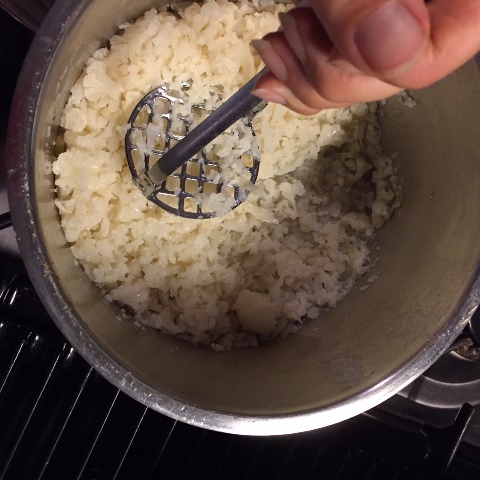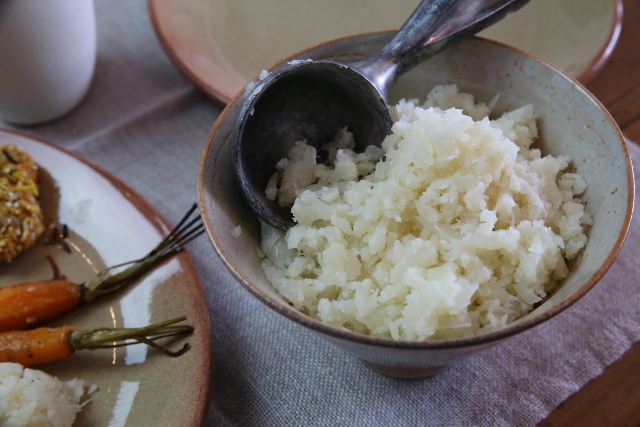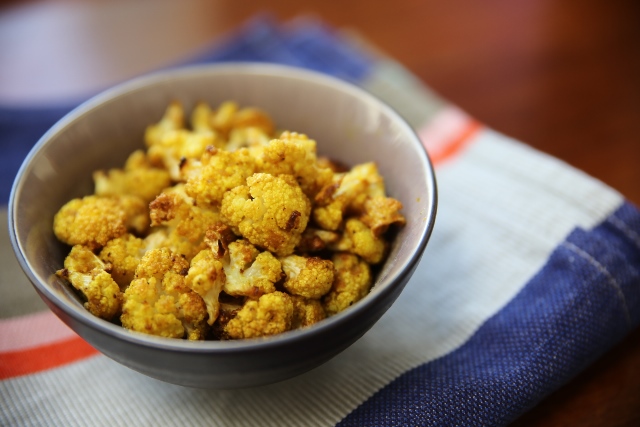- Home
- Blog
- Healthy Cooking
- Crazy for cauliflower
Crazy for cauliflower
Written by Catherine Saxelby
on Wednesday, 14 October 2015.
Tagged: fibre, health, healthy cooking, healthy lifestyle, high fibre, lower carb, nutrition, vegetables

Cauliflower is the darling of the moment, the trendy, vegetable-du-jour! This versatile and nutritious vegetable has many ardent followers who not only adore its flavour and texture, but also love it as a low-carb swap for potato, pizza base or cous-cous. Here’s how to make more of this star veg.
A beautiful brassica
Cauliflower belongs to that wonderful Brassica family of mustard-smelly veges that includes cabbage, broccoli, Brussels sprouts, kale, kohlrabi, swede, turnip and the fashionable kale (also sold as regular or Tuscan kale aka Cavalo Nero).
All these Brassica are rich in indoles and isothiocyanates, those smelly sulphurous compounds that do our bodies the world of good. They can protect against cancer of the bowel.
Fabulous for fibre
Cauliflower rates tops for fibre, a food factor that keeps your large bowel healthy. This fibre is why my Gran called it a ‘windy’ vegetable (along with cabbage) but that same fibre makes cauliflower bulky and filling, which is good for appetite control. You feel full, so eat less! Fibre also adds to your gut biome so you can grow your own friendly bacteria to fight off the bad guys.
Vitamin rich
Nutritionally cauliflower is up there with the best and it rivals its cousin, cabbage, thanks to its high fibre content, vitamins and minerals. All this for a tiny 100 kilojoules or 24 Calories per 100g. It might surprise you to know that cauliflower is a source of vitamin C and folate – so it pays to eat some of it raw or lightly cooked, as these two vitamins are heat-sensitive and easily reduced. See my first cauli-rice cooking method below.
It’s also a good source of vitamin K (so not suitable for those on blood thinning medication) and the other B vitamins.
Low calorie and low carb
Cauliflower is low in kilojoules/Calories. You could munch on a whole cup of raw florets (weighing 100 grams) and have ingested a mere 100kJ or 24 Cals. And that same 100g contains only a tiny two grams of carbs!
Yes it’s smelly, but so tasty!
Yes it does have a distinctive, strong odour that somehow pervades the whole house. This comes from the sulphides (as in rotten egg gas), ammonia and other volatile compounds.
How to minimise that? The best thing is not to overcook the cauliflower. There are many ‘home remedies’ for minimising the smell but I’ve never tried them. If you have, then please let me know if they work. They include:
- not using aluminium or iron pots
- refreshing the cauliflower in ice water when cooked
- adding some bread to the cooking water
- adding some white vinegar to the cooking liquid and
- adding a bay leaf to the cooking pot.
Finally it tastes delicious and can be served in so many ways including as a low-carb, low-calorie substitute for potato, rice and cous-cous.
New ways to cook cauliflower
Sick of Cauliflower Cheese? Tired of Cauliflower Soup? Take a look at these three great new ways to use cauliflower:
1. Cauliflower Rice
This easy-mash version of cauliflower is a neat swap for cooked white rice or couscous, thus dramatically cutting back on carbs plus upping the fibre. Here are my two methods:
- Pulse in the blender for 2-3 seconds to break into tiny bits. Then “steam” in a wok or large pot with the cover on, turning to prevent sticking, then serve.
or
- Cook, then coarsely mash with a potato masher. This works well when you can’t be bothered getting out the food processor and makes a chunky side dish.
Here’s a recipe if you want specific amounts:
½ head cauliflower, about 750g
2 tablespoons milk
1-2 tablespoons butter (or use 2 tablespoons coconut fat in place of the milk and butter)
Trim leaves and larger stalks from the base. Cut the cauli into individual florets roughly the same size. Place in a medium saucepan, cover with water and add a pinch of salt. (Tip: you can speed up the cooking time by using boiling water).
Cover and bring to the boil, then lower the heat and cook for 15 minutes at a simmer. Test for tenderness by piercing an inner thick stalk with a sharp knife – you want it to be well cooked and soft so it will mash better. No hard core.
 Remove the cauliflower from the heat and drain well. Cover and leave it to “steam” in its own heat for a minute.
Remove the cauliflower from the heat and drain well. Cover and leave it to “steam” in its own heat for a minute.
[You can cook 30 minutes ahead and leave the cooked cauliflower covered in its own heat until you’re ready to serve.]
Mash with a potato masher so you get coarse chunks with texture. Add milk and butter, mash through again to combine.
Makes 3 cups, serves 4-6 as a side
2. Cauliflower Mash
Make as above but finish off by pureeing the cooked cauliflower with a handheld stick blender for a smoother texture like mashed potato. Add milk and butter, stir or mash well again to combine.
3. Spicy roasted cauliflower
Serves 4 as a side or 8 as a nibble
Prep time 15 minutes
Cooking time 25 minutes
1 medium or ½ large cauliflower, around 1.25 kg total weight including outer leaves
2-3 tablespoons olive oil
2 cloves garlic, crushed
1 teaspoon ground cumin
1 teaspoon ground coriander
Juice of ½ lemon (allow 2 teaspoons)
Break or cut the cauliflower into large florets about the same size. You should have around 700g in final floret weight. In a bowl or bag, combine the oil, garlic, cumin, coriander and lemon juice. Add the florets and mix to coat the outsides evenly with the spice mixture. I like to combine the oil and spices in a plastic bag then tip in the florets and “massage” to coat with the mixture.
Pre-heat oven to moderate 180°C. Line a large baking tray 20 x 30cm (8x12") with baking paper. Arrange the florets in a single layer on the tray. Roast for 15 minutes or only 10 minutes if the florets are small. Turn once and continue cooking for a further 5 minutes or until just tender in the centre stalk (thickest part) when pierced with the tip of a sharp knife.
Arrange cauliflower florets on a serving tray and serve warm or cool with tahini or yoghurt as a dipping sauce. Or serve as a vegetable side to roast chicken or barbecued fish.
Variations
- No cumin or coriander? Use 2 teaspoons of a medium curry powder instead.
- Love something more spicy? Add ½ teaspoon dried chilli powder to the spice mix. Or deseed and finely chop 1 fresh red chilli and add in with the spices.
But that’s not all…
The internet recipe sites abound with other innovative ways to use cauliflower from pizza bases to cauli fried rice. It’s a versatile, nutritious and high fibre veg that’s worth adding to your family’s menu, so why not experiment?
Foodwatch
The Good Stuff
The Boring Stuff
© 2025 Foodwatch Australia. All rights reserved
Website by Joomstore eCommerce












